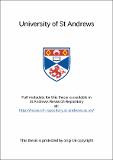Studies of excitotoxicity in cerebellar granule neurons
Abstract
Excitotoxicity is defined as neuronal cell death caused by hyperactivation of ionotropic glutamate receptors (namely NMDA-, AMPA- and KA-receptors). The excitotoxic potential of a novel AMPA receptor subtype-selective agonist, (S)-CPW 399 was investigated, using 7 div cultured cerebellar granule neurons as an in vitro model system of glutamatergic neurons. The results demonstrate that (S)-CPW 399 induces excitotoxicity by stimulating Ca²⁺ influx through Ca²⁺-permeable AMPA receptors, with no other coincident mechanism of Ca²⁺ infux being involved. Uniquely among AMPA receptor-selective agonists, (S)-CPW 399 appeared to have the ability to induce AMPA receptor-mediated functional responses without the need for blockade of AMPA receptor desensitisation. These results suggest that (S)-CPW 399 may be used as a pharmacological tool to aid in the investigation of the role of AMPA receptors in excitotoxicity and their molecular mechanisms of desensitisation.
In a supporting study, it was shown that classic desensitising AMPA receptorselective agonists produced similar results to that seen for (S)-CPW 399 under an identical experimental paradigm only when AMPA receptor desensitisation was inhibited by cyclothiazide.
Previously published data suggest that the normal physiological temporal profile of c-fos mRNA expression following stimulation of cells is altered following excitotoxic insult. More precisely, the transient expression observed under non-excitotoxic conditions is replaced by delayed, elevated and sustained expression under excitotoxic conditions. As a result, it has been postulated that ratiometric analysis of c-fos mRNA expression at selected timepoints following stimulation could provide a mechanistically relevant in vitro predictive test for excitotoxicity. This was assessed in an industrial context using real time RT-PCR for mRNA quantitation following exposure of granule cells to high and low concentrations of excitotoxic and non.- excitotoxic compounds. The results suggest that the proposed test requires further modification and validation to achieve a robust, reliable large-scale screening test for excitotoxic potential of compounds.
Type
Thesis, PhD Doctor of Philosopy
Collections
Items in the St Andrews Research Repository are protected by copyright, with all rights reserved, unless otherwise indicated.

